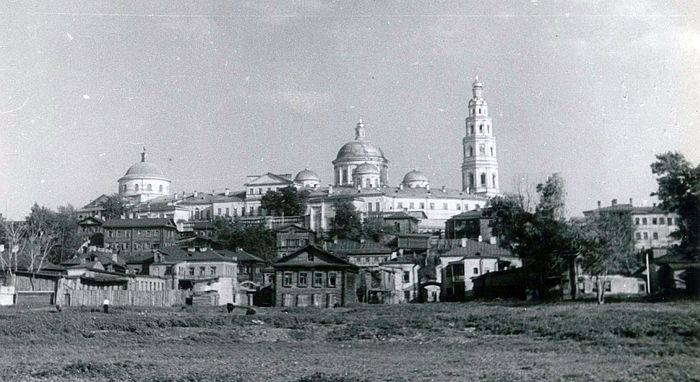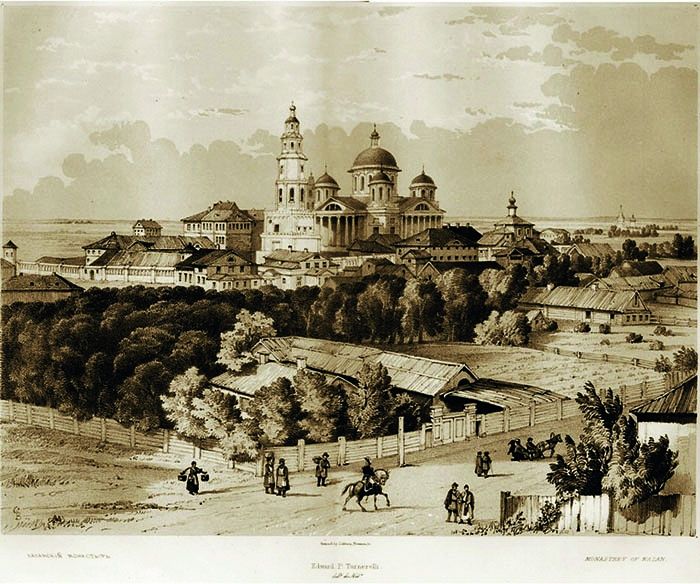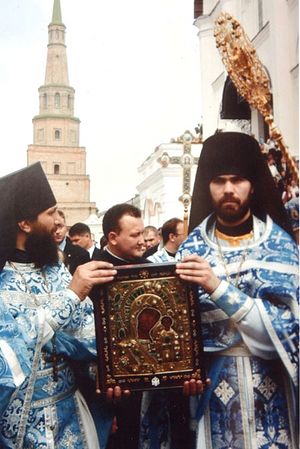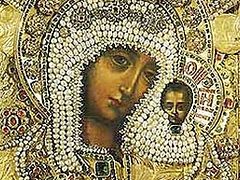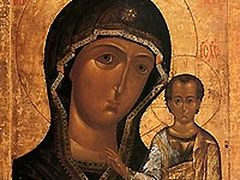The history of the Kazan icon began in the sixteenth century. Yet people find the circumstances and place of its appearance unusual and surprising even to this day.
The history of the Kazan icon
The icon’s discovery
The Kazan icon first appeared in the city of Kazan in 1579, when that city was still far from being “Russian”. Only twenty-seven years had passed since the conquest of the Kazan Khanate by the troops of Ivan the Terrible in 1552, and twenty-six years had passed since the creation of a diocese of the Russian Orthodox Church on its territory in 1553. The local population (predominantly Muslim) was not very happy about that event either. More than that, just before the miraculous apparition, in June 1579 the city had been ravaged by a devastating fire and the locals blamed Christians for that. However, it was at that city and during those turbulent times that the Most Pure Virgin deigned to send Her holy icon to Christian people.
The appearance of the Kazan icon
This is how the appearance took place. Soon after the devastating fire, the Mother of God appeared to Matrona, a nine-year-old daughter of a strelets [a member of the infantry regiments in the sixteenth and seventeenth century Russia], and told her to find Her icon amid the ashes of a burned house. After the first vision nobody believed the girl. But the apparitions of the Queen of Heaven continued and the girl kept asking the adults to find the icon. Soon Matrona’s mother turned to Orthodox priests, asking them to help her. However, the clerics didn’t believe her story and were reluctant to search for the icon. It was not until numerous appeals to the bishop of Kazan that it was decided to try and find the holy object. At last the icon (wrapped in an old cloth) was found. According to tradition, as soon as Matrona started digging she discovered it. By orders of Tsar Ivan IV a convent in honor of the Mother of God and a church were built on this site, and the first copy of the icon was sent to Moscow.
The Time of Troubles
The history of the Kazan icon during the Time of Troubles (1605-1613)1 is inseparably connected with the name of the Hieromartyr Hermogenes, Patriarch of Moscow and All Russia, who was the first to inspire the population to rise up in defense of Russia and Orthodoxy against the Polish invaders as well as the internal strife, which posed even a greater danger.
 The first church built in the seventeenth century in honor of the Kazan icon in the village of Kolomenskoye (now within Moscow). From Wikimedia.org/Ludvig14
The first church built in the seventeenth century in honor of the Kazan icon in the village of Kolomenskoye (now within Moscow). From Wikimedia.org/Ludvig14 Incidentally, Patriarch Hermogenes was the author of the “Tale” of the Kazan icon. He wrote it in 1594 as Metropolitan of Kazan. Its full name is “The Story and Miracles of the Most Pure Theotokos and the Holy and Glorious Appearance of Her Image in Kazan”. And it was he who composed the service to this icon.
By the end of 1610, the atmosphere in Russia became extremely tense. It is widely known that Polish aristocrats wanted to sieze power in the country, but we need to keep in mind why it became possible: The worst tragedy of the Russia of that time was anarchy caused by the civil war rather than a foreign invasion. Cities and influential boyar [members of old aristocracy in Russia, next in rank to a prince] clans were fighting with one another. The country was flooded with bands of Cossacks and vagrants who in pursuit of easy profit would plunder, rape and kill. Most people were only nominally Orthodox, while their habits and lifestyle were barbarous.
Patriarch Hermogenes was taken into custody. Realizing the disastrous situation, he started sending his messages to all the regions of the tsardom, calling on everybody to stop the discord, unite and organize resistance in order to liberate the country from the enemy. He urged the citizens not only to defend their motherland but also to guard the Orthodox faith and prevent violence against common people.
The patriarch’s speeches had their effect: Prince Dmitry Pozharsky and Kuzma Minin organized an all-Russian volunteer army with its center in Nizhny Novgorod. They led the army from Nizhny Novgorod to Moscow.
When the volunteer army entered Yaroslavl it was joined by the Kazan residents who had brought a copy of the Kazan icon with them and handed it over to Dmitry Pozharsky. This was in 1611. From that moment the Theotokos became the spiritual “Commander” of the all-Russian voluntary army and of the whole the nation.
By the autumn of 1612, the situation had become complex. On the one hand, the Poles that took cover at the Kremlin found themselves in a vicious circle, suffering from hunger, diseases and their own differences, and cargo wagons that had been sent to them from outside were intercepted by the Russian volunteer corps. On the other hand, deep dissension developed amongst the volunteer army officers as well. It finally became clear that they couldn’t hesitate any more. Before taking the Kremlin by storm, the members of the Russian volunteer army kept strict fast and prayed very hard before of the Kazan icon for three days. [The storm was successful and the Polish Catholic aristocrats were expelled finally from the Kremlin.—OC.]
The return of the Kazan icon of the Theotokos
In 2004, a copy of the Kazan icon of the Theotokos returned to Russia. Initially it was believed to be the original icon that had been found in 1579. However, the joint Russian-Vatican commission determined that it was a later seventeenth-century copy. But what became of the original icon? Historical sources mention one vision associated with the intercession of the Mother of God. Archbishop Arsenius of Elassona who was in the Kremlin during its siege had a vision of St. Sergius of Radonezh the night before the storming. According to tradition, the saint said to the archbishop: “Arsenius, our prayers have been answered. Through the intercession of the Theotokos the Lord’s judgment upon our homeland has been changed to mercy. In the morning Moscow will be in the hands of the insurgents and Russia will be saved.”
On the next day, October 22, 1612, the Russian forces stormed Kitai-Gorod [a walled area near the Kremlin.—OC.] and two days later retook the Kremlin.
On October 25, 1612, Russian volunteer army officers walked in a cross procession into the Kremlin, carrying the Kazan icon of the Mother of God, the Protectress of the Russian land, at the head of the procession.
According to the Nikon Chronicle, following the liberation of Moscow from the Polish invaders Prince Dmitry Pozharsky left the Kazan icon at the Church of the Presentation of the Mother of God in the Temple on Lubyanka Street in the center of Moscow. In 1636, this icon was moved to the newly-built Kazan Cathedral in Red Square. This cathedral was constructed to commemorate the liberation of Moscow from the Poles.
Since 1649 October 22/November 4 has been a national holiday and feast in honor of the Kazan icon that saved Russia in the Time of Troubles.
The Kazan icon in the War of 1812
In 1812 the All-Holy Theotokos again showed Her mercy to the Russian people through her holy Kazan icon.
It is known that before his departure for the Russian active army General and Field Marshall Mikhail Illarionovich Kutuzov prayed in front of the Kazan icon.
One of the most remarkable examples of the help of the wonderworking Kazan icon to the Russian soldiers during the Patriotic War of 1812 was the result of the Battle of Vyazma (October 22). On that day, the feast of the Kazan icon, the rear guard of the French Marshall Davout was defeated by Russians commanded by General Mikhail Andreyevich Miloradovich and General of Cavalry Matvei Ivanovich Platov.
The French suffered heavy casualties (7,000 to 8,000). This battle was the first defeat of Napoleon’s Army after its retreat from Moscow.
In 1811, the Kazan Cathedral was completed in St. Petersburg. After the War of 1812 it became a memorial church for the Russian Army. Later Prince Mikhail Kutuzov was buried there. It is no coincidence that this cathedral was chosen as the place of perpetuation of Russia’s military glory, as the Holy Theotokos became the spiritual Protectress and “Heavenly Commander” of the Russian people in 1812 (as it had been during the Time of Troubles).
The icon is stolen
From the moment of its appearance, the original icon was kept at the Convent of the Holy Theotokos in Kazan until the early twentieth century. But in those troubled years of the revolution the Lord took this wonderworking icon away from His people, perhaps for their edification or humility. Over that period many Russian people apostatized and drifted away from their faith, the faith of their forefathers. This was most likely one of the reasons for that tragedy. Today, after so many years, we can retrace those events.
On the night of June 29 (according to the old calendar), 1904, the Kazan icon of the Holy Theotokos was stolen.
It is believed that those who committed the theft had chosen the right moment for their crime. For four days before the theft, the convent had been visited by the Smolensk icon and long solemn services had been celebrated daily. On June 28 the Smolensk icon was carried out from the convent, and after the vigil service all the nuns went to their cells. After two in the morning a novice named Tatiana Krivosheeva went out to the yard and heard cries for help. As it turned out, the convent’s guard Fyodor Zakharov was the one shouting. He was found locked in the cathedral’s vault.
The exact location of the break-in was found. The miracle-working Kazan icon, along with an icon of the Savior, were missing, so it was clear that these were thieves and not vandals. Both icons had been in the iconostasis before the theft, and the robbers most likely coveted their gold coverings. Later it was recorded that besides the icons, 365 rubles (of donations) had disappeared from the church shop.
News of the theft of the icon quickly spread not only around Kazan but all over Russia. Fortunately, the culprits were soon found thanks to the superintendent of the Alexander Trade School, Vladimir Volman, who provided invaluable information to the police. Due to the well-coordinated efforts of all those who were not indifferent to the tragedy, the police got on the tracks of the prime suspect Bartholomew (Varfolomei) Chaikin (Stoyan), a twenty-eight-year-old peasant. On July 5 he and his mistress Praskovya Kucherova were detained in Nizhny Novgorod, to which they had fled on the Niagara steamer.
During the search of Chaikin’s apartment, jewelry and fragments of the ornaments from the icons of the Mother of God and the Savior were found. However, there were no icons in the apartment. According to the nine-year-old Evgenia, daughter of Chaikin’s mistress, the icons had been cut into pieces and burned in the stove. Similar evidence was provided by other individuals who were called to testify, including Praskovya’s mother, Elena Shilling.
On November 25, 1904, judicial proceedings began at the district court of Kazan. Bartholomew Chaikin (Stoyan), Ananias Komov (accessories to the crime), Fyodor Zakharov, Nikolai Maximov (partners in the crime), and Praskovya Kucherova and Elena Shilling (who covered up the crime) appeared before the court as defendants.
Following protracted hearings, Bartholomew Chaikin (Stoyan) was sentenced to twelve years of penal servitude, Ananias Komov to ten years of penal servitude, Maximov was sent to correctional facilities for two years and eight months, and Proskovya Kucherova and Elena Shilling were imprisoned for five months and ten days. The guard Fyodor Zakharov, who had been suspected of complicity in the crime, was acquitted.
According to the major version, these two icons were burned by the perpetrators. However, in time new versions turned up. For example, some supposed that Chaikin may have sold the icons to Old Believers as they were very valuable even without their oklads (covers). The fate of the Kazan icon remains unknown even today.
The whereabouts of the Kazan icon
Our days. The return
The story of the Kazan icon continued to our days. In 2004, negotiations were held for a possible meeting between Patriarch Alexei II and Pope John Paul II. The fact is that since 1993 the Holy See had possessed an icon of the Theotokos of unknown origin. The art historians eventually arrived at the conclusion that it was one of the copies of the Kazan icon.
Although the meeting between John Paul II and Patriarch Alexei II never took place, the icon was delivered to Moscow by a Catholic delegation headed by Cardinal Walter Kasper in August 2004. On August 28 it was handed over to Patriarch Alexei II at the Moscow Kremlin’s Dormition Cathedral. It was decided to move the icon to Kazan, and before that event it was kept at the patriarchal residence.
In April 2005, during his archpastoral visit to Kazan, Patriarch Alexei II celebrated the Divine Liturgy at the Annunciation Cathedral of the Kazan Kremlin. After the Liturgy he presented the Diocese of Kazan with the Kazan icon of the Mother of God that had been received from the Vatican. The relic was placed inside the Church of the Exaltation of the Cross of the former Convent of the Theotokos where it had originally been kept. Thus it can be said that this event was like “the second discovery of the holy icon of the Theotokos”.
The original of the Kazan icon
It should be noted that when it comes to icons, the term “original” is relative. Any blessed image of the “Mother of God of Kazan” is a holy object in front of which anybody can pray. The Most Holy Virgin always hears our prayers no matter what kind of an icon we are standing before, be it paper or painted.
According to tradition, the icon that was revealed to the girl Matrona in 1579 and which was lost in the early twentieth century is referred to as “the original Kazan icon”.
Copies of the Kazan icon
 The icon of the Holy Trinity Cathedral is one of the earliest copies of the wonderworking original icon. It was painted in the eighteenth century. It was subsequently repeatedly repainted. The original image (of this copy) was thus hidden under several layers of paint. In 2005, the icon was restored
The icon of the Holy Trinity Cathedral is one of the earliest copies of the wonderworking original icon. It was painted in the eighteenth century. It was subsequently repeatedly repainted. The original image (of this copy) was thus hidden under several layers of paint. In 2005, the icon was restored The revered copies of the Kazan icon that existed in different regions of Russia were numerous and diverse.
The icon in the volunteer army
Thus, one of the venerated copies of the Kazan icon was kept in the camp of Prince Dmitry Pozharsky’s Russian voluntary corps during the war against the Polish and Swedish invaders between 1611 and 1613. A special annual commemoration of the Kazan icon of the Theotokos was instituted for October 22 in gratitude for the deliverance of Moscow from the Polish usurpers. Initially it was celebrated only in Moscow, and in 1649 it became a nationwide festival.
It was at the same time that the first church in honor of the Kazan icon was built in Kolomenskoye.
The St. Petersburg copy
In the eighteenth century, the Kazan icon was held in great esteem by both Peter I “the Great” and Catherine II the Great. Thus, it was under Peter I, in 1721, that one of the venerated copies was transferred to St. Petersburg; earlier, in 1709, on the eve of the Battle of Poltava, Tsar Peter prayed with his army in front of the Kazan icon, and they were victorious. In 1768, Catherine II adorned the cover of the original icon at Kazan with a diamond crown as a token of her reverence for the relic.
 The great relic of St. Petersburg. It was brought here by the tsar in the first days of the city’s existence. It is kept at the Kazan Cathedral
The great relic of St. Petersburg. It was brought here by the tsar in the first days of the city’s existence. It is kept at the Kazan Cathedral By the end of the nineteenth century, the Kazan icon became one of the most revered icons inside Russia. It was cherished by the entire Orthodox population. At that time one couldn’t find a single believer who didn’t know about the original Kazan icon or its copies.
The Kazan icon in Moscow
You can find Kazan icons of the Mother of God in most churches of Moscow, first and foremost in the Kazan Cathedral in Red Square. It was restored in 1993. It holds a revered copy of the Kazan icon.
A modern Kazan icon of the Theotokos can be found in the lower part of the Patriarchal Cathedral of Christ the Savior (called the Church of the Transfiguration). Parishioners of the main capital’s cathedral often pray in front of this icon.
Among the numerous relics of the Church of the Holy Prophet Elias in Obydensky Lane you can find one Kazan icon of the Theotokos. It also houses a particle of the Cincture of the Blessed Virgin. The church is open daily from 7:00 AM till 10:00 PM.
The capital’s Theophany Cathedral (commonly called Elokhovo Cathedral) has a copy of the miracle-working Kazan icon which was formerly kept at the Kazan Cathedral in Red Square.
 The Kazan icon of the Mother of God with Sts. Timothy and Mary Magdalene on the margins. Russia, the late eighteenth century
The Kazan icon of the Mother of God with Sts. Timothy and Mary Magdalene on the margins. Russia, the late eighteenth century At the Church of the Protecting Veil of the Mother of God on Lyshchikova Hill, visitors can venerate a copy of the Kazan icon along with the relics of the New Confessor Priest Roman Medved, who reposed in the late 1930s in Maloyaroslavets (the Kaluga region) after numerous arrests and exiles.
There is a unique Kazan icon painted on glass at the Church of St. Poemen the Great in Moscow.
The St. Nicholas Church at Bersenevskaya Embankment near the Kremlin is very interesting. It holds long services and maintains some Old Ritualist traditions. One of its relics is a much revered copy of the Kazan icon.
Of course, this list is incomplete. Indeed it is difficult to find a parish church of Moscow which doesn’t have a copy of the Kazan icon of the Theotokos!
A description of the Kazan icon
The Kazan icon is a half-length (or head to shoulders) version of the icon of the Theotokos of the Hodegetria (“She who shows the way”) type. On it the Infant Christ sits on Mary’s arms, blessing with His right hand and holding a scroll or a book in His left hand.
On the Kazan icon the Virgin Mary is depicted bust-length, in typical garments, slightly inclining her head towards the Christ Child. The Savior looks directly at us; He is depicted waist-length, with His right hand in a gesture of blessing.
On how the Kazan icon helps us
The view that each type of icon of the Theotokos helps us in specific situations differs from the teaching of the Orthodox Church. Metropolitan Anthony (Bloom) of Sourozh used to say that a newly-painted icon becomes holy as soon as it has been blessed. Before that, any icon is just an image of Christ, His Most Holy Mother or a saint, painted on wood. Of course, Christians don’t venerate paint and wood, or any other material. The VII Oecumenical Council in 787 proclaimed the veneration of holy icons. According to its decree, “The honor paid to the image passes on to that which the image represents, so he who reveres the image reveres in it the subject represented.”
However, some icons are considered wonderworking; that is, Christ helps people and whole nations through the prayers of believers who pray before them. So the Kazan icon was particularly venerated in Russia, and the Mother of God healed the sick and saved that country through the petitions of the faithful who prayed before it.
We have recounted how prayer before the wonderworking Kazan icon saved Russia from the Polish invasion in 1613. In 1812, the Army of Napoleon, one of the most famous military commanders in the world, attacked Russia, and the prayer to the Queen of Heaven again helped the nation defeat the aggressors. As we know, Napoleon’s “La Grande Armee” numbering thousands of soldiers finally fled in defeat.
The Theotokos helped the Russian people in the Great Patriotic War [part of the Second World war fought by the Nazy Germany and its allies against the USSR; 1941-1945] as well. The Mother of God is credited with helping civilians survive amidst the horrors of war, and helping soldiers crush the monstrous enemy.
Churches dedicated to the Kazan icon of the Theotokos
The Kazan Cathedral in Red Square
The most famous cathedral in honor of the Kazan icon was constructed in the first half of the seventeenth century under Tsar Michael Romanov. Though it was rebuilt many times, it remained one of the principal churches of Moscow. It kept the wonderworking copy of the Kazan icon that helped the Russian volunteer army drive out the Poles from the Kremlin.
In 1812, Napoleon’s soldiers desecrated the cathedral by dragging a dead horse into the sanctuary.
In September 1918, the wonderworking Kazan icon of the Mother of God was stolen from the cathedral. In the late 1920s the cathedral was restored with the funds of the parishioners. In 1936, the Bolsheviks demolished the church and a public toilet stood on the spot for some time.
In 1990-1993 the cathedral was rebuilt using surviving old photographs and drawings. Its main relic is a revered copy of the Kazan icon.
The Kazan Cathedral in St. Petersburg
The construction of one of the symbols of St. Petersburg commenced on August 27, 1801, in the presence of Emperor Alexander I. Ten years later the cathedral was completed and consecrated by Metropolitan Ambrose of St. Petersburg. After the war of 1812 it became a monument to Russian victory. In 1812, the war trophies were displayed in it, including French military banners and the personal baton of the French Marshall Davout. It was here that Field Marshall Kutuzov was interred after his death, and here that the funeral service was performed over the composer Pyotr Tchaikovsky.
In 1932 the church was closed, and soon it was used as the Museum of the History of Religion and Atheism. The first Liturgy after its closure was celebrated there in 1991.
The cathedral’s main relic is a wonderworking Kazan icon of the Theotokos.
The Church of the Kazan icon in Kolomenskoye
The church was built in the first half of the seventeenth century, but its walls weren’t covered with frescoes until the early twentieth century. In the Soviet era the church was closed temporarily in 1941 and 1942 during the Great Patriotic War.
Its main relic is the “Reigning” icon of the Theotokos. It appeared on March 15, 1917, in the vault of the Holy Ascension Church in Kolomenskoye on the day of Nicholas II’s abdication. In the Soviet era the relic was kept in storage rooms of the State Historical Museum. In 1990, the icon was given to the Church of the Kazan icon in Kolomenskoye.
The church also houses a copy of the wonderworking Kazan icon.
The Church of the Kazan icon in Irkutsk
This Byzantine-style church was completed in 1892, having taken nine years to build. Many wealthy parishioners took part in the construction work by donating money, icons, church vessels, books, cloths embroidered in gold, and vestments. The temple was closed in 1936. Its building became home to the storehouse of a book-selling organization, courses for film projectionists, and the factory “Siberian Souvenir”.
At the end of the twentieth century the church was returned to the faithful. Now it functions as the cathedral of the Metropolitanate of Irkutsk and Angarsk.
The Church of the Kazan icon in the Kazanskoye village, the Pavlovsky Posad district near Moscow
This church was constructed in the mid-nineteenth century. According to tradition, in 1812 the Kazan icon miraculously appeared here and helped volunteers from among the local residents fight against the French Army soldiers. According to another version, this church was built with the blessing of the Holy Hierarch Philaret (Drozdov) of Moscow, who visited the village and gave it the Kazan icon.
The church was built between 1859 and 1863. It stayed open throughout the Soviet period and housed many relics from the neighboring churches that had been closed down.
The Church of the Kazan icon at the monastery of Kazan
It stands on the site where the original Kazan icon was discovered by the girl Matrona in 1579. Soon the convent in honor of the Mother of God appeared there and Matrona became its first nun. The volunteer army of Minin and Pozharsky took this icon to Moscow and gave it back after liberating the capital.
In the Soviet era the convent was closed down. The restoration of the holy place commenced in 1994, and since 2005 it has functioned as a monastery with a community of monks. Not long ago, plans for the reconstruction of the Church of the Kazan icon in the city of Kazan were announced. On July 21, 2016, Patriarch Kirill blessed the construction site of the new church.
The abandoned Church of the Kazan icon in the Yaropolets village near Moscow
This is one of the best known abandoned churches in honor of the Kazan icon.
Before the Russian Revolution, the manor of Counts Chernyshev was situated here.
The construction of a large stone church began in 1780. There were plans to add a family burial vault to it. However, misfortunes pursued this place from the very beginning: First the head of the family, General and Field Marshall Chernyshev, died; then the roof of the almost complete church collapsed. It was decided to restore the unfinished edifice and invite a new architect, namely Karl Ivanovich Blank. At last, in 1797 the church was consecrated, yet its interior furnishings and decorations remained incomplete.
In 1830, the church caught fire, but survived. The first icons didn’t appear in the church until the end of the nineteenth century. Moreover they were painted on canvas rather than wood and resembled pictures.
The church is unique for its unusual shape. Two symmetrical parts (large aisles, “churches”) are connected by a vestibule in the middle. Above the central entrance you can see the “all-seeing eye” symbol (an eye enclosed by a triangle). Believers observed these features with suspicion, and there were rumors that it was a “masonic temple” rather than a Christian church!
During the Soviet-era persecutions the church was heavily damaged. It was robbed several times. During the Great Patriotic War the west part of the church was hit by a mortar shell.
After the end of the war the church was returned to the faithful, but in 1966 the priest who served in it sadly died. For a time the church was converted into a “house of culture” [in the USSR and other Communist countries these were huge club-centers for all kinds of recreation and cultural activities within communities]. There were attempts to restore it in the 1970s, but due to the funding shortage the work stopped, and the church was robbed again.
As of 2006, the state of the church was disastrous: the roof leaked and the water was gradually damaging the stuccowork inside the church. The corner of the principal front’s portico had caved in, and the columns could fall any day. This splendid architectural masterpiece was crumbling away.
At last the church ownership was transferred to the Russian Orthodox Church, which initiated its restoration not long ago.

